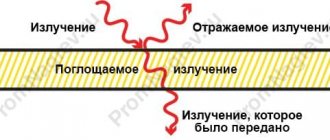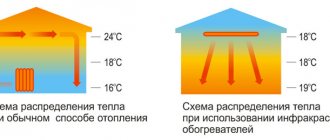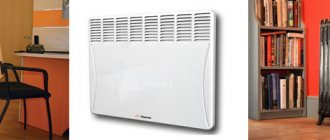Providing additional heat in a residential or commercial space is the most important factor in comfort when cold weather sets in.
To understand whether a convector or an infrared heater is better, we decided to analyze the main features of devices of these types.
For the analysis, the following criteria were taken: operating principle, level of environmental friendliness and safety, price factor, dimensions, comfort of use, speed of heating the room, mobility and others.
What is the difference between an infrared heater and a convector?
Convectors
Convector heaters are available in electric and gas models. In residential settings, electric models are used. They are used in apartments, houses, country houses, office premises - in all buildings where electrical power can be connected.
The principle of operation of the convector . The convector heats cold air and distributes the heated air evenly in the heated room. Convectors do not emit heat, like many heating devices, but fill the room with it.
The device is placed at a height of no more than 15 cm from the floor level. Then simple laws of physics apply: cold air is at the bottom, because it is heavier than warm air - it enters the heater through a special grille and passes through the radiator. Passing through the radiator it heats up and enters the room. Warm air rises. As it cools, it lowers and the procedure is repeated, ensuring constant heating of the air in the room.
Design features . The heater consists of two main parts: a housing (convection chamber) and a built-in heating element. The heating element does not contact the metal body, so grounding is not required. Between the heating element and the body there is a protective layer made of special heat-resistant plastic. The air exchange process is carried out naturally, without additional parts inside the structure. Due to the absence of a fan, the convector operates silently.
Modern convectors are equipped with a thermostat, which ensures that the air temperature in the room is maintained with a high level of accuracy. The user sets the desired temperature, and the thermostat turns the device on and off as needed. Control modules allow you to combine several convectors into a group and fully control the microclimate in the house.
Convectors are equipped with various additional options that help ensure maximum indoor comfort. The device can be equipped with a timer, electricity connection indicators, a remote control device, and an air humidifier.
1. Front panel. 2. Grill with guides for the release of warm air.
3. Power button. 4. Temperature adjustment.
5. Electronic module. 6. Closed heating element. 7. Temperature sensor.
Infrared heater
An infrared heater is a modern heating device used to heat rooms for various purposes.
The operating principle of an infrared heater . The operating principle of this device can be compared to the sun's rays. An infrared heater works by heating objects in a room using infrared radiation - in turn, they release heat to the air. This allows you to heat small areas or create local heating. To obtain the desired effect, you do not need to wait until all the air in the room or office is heated.
Design features . The main structural element is the emitter, which emits infrared radiation and provides heating. Depending on the type of device, a halogen, carbon, ceramic or tubular heating element is used.
The reflector is a structural part that provides directional heating and protection against overheating of the housing. Made from modern materials with a high level of thermal resistance in a parabolic or linear shape.
A protective part in the form of a grille or partition to protect against direct contact with the hot surface of the emitter, a necessary element for a device used in a residential apartment or house.
1. Carrying handle. 2. Protective grille.
3. Emitter. 4. Power button.
5. Reflector. 6. Leg.
Heating speed and features
Convectors work by filling the room with warm air through natural convection. These devices do not use fans or other additional elements that speed up the heating process. Therefore, the heating rate is low relative to infrared devices.
The operating principle of an infrared heater provides fast and targeted heating under the influence of infrared radiation. But first of all, objects, walls and people heat up, and from them the air in the room is heated. It has been experimentally confirmed that heating is felt within 27 seconds. The targeted action of an infrared heater allows you to achieve a comfortable temperature in the area of the room where people are located. In this case, the accumulation of warm air near the ceiling will be minimized.
Differences in heat distribution when using a convector and ceiling infrared heater.
A person will feel the heat most quickly from an infrared heater, but if we talk about uniform heating of the air throughout the entire room, then a convector will handle it faster. The targeted action of an infrared heater allows the use of these devices in places where there are drafts - on terraces, gazebos and industrial premises. The convector is able to provide uniform heating of the air in a closed room.
Fan heaters - inexpensive, but noisy
These devices are available in various sizes. The larger the fan blades installed inside the case, the larger the dimensions of the device. The heating air passes either through a metal spiral or through a ceramic heating element. Heat ventilation is the fastest way to raise the air temperature in a room.
We turned on the device - and after half an hour the room became noticeably warmer. Moreover, from 1 to 1.5 kilowatts of power of such a device is enough for not 10, but 25 square meters of area.
The simplest, portable fan heater.
pros
- They are the cheapest - models with a spiral can cost 500 rubles, the price of devices with a ceramic plate starts from 1.1 thousand rubles.
- They are the most economical - they consume about 1-1.5 kilowatts of power.
- They have a thermostat that instantly turns off the device if it overheats.
- They are very light and easy to carry from room to room.
Minuses
- These heaters are too noisy.
- They overheat quickly, so they cannot be used continuously for long enough.
- They raise a lot of dust.
Which heater is more comfortable to use?
Electric convectors are presented in two model options, based on installation features. Wall-mounted models are attached to the wall at a height of 10–15 cm from the floor. Installation does not take much time. Once the device is mounted on the wall, it does not interfere with movement in the room and is not noticeable.
Floor-standing models are compact, equipped with wheels or stand legs. Due to its light weight and parameters, the device is easy to transport from one room to another. The presence of additional functions increases ease of use.
Infrared heaters are divided into mobile and stationary. Mobile models of infrared heaters can easily be moved within a room or transferred to another room. However, the body of an infrared heater often gets very hot, so you need to be careful when changing the orientation of the device or moving it to another room. Although the protective mesh protects from direct contact with the emitter, it has a fairly high temperature.
As for stationary infrared heaters, they are practically no different, in this regard, from convector heaters. They are installed on walls or ceilings and do not cause any inconvenience to the occupants of the room.
Convectors will be more comfortable to use. They do not require the same control as infrared devices. A convector can easily be left unattended, while a powerful infrared heater can emit a large amount of heat, which can lead to negative consequences for both a person and nearby surrounding objects. Both devices are silent. However, users note that some models of infrared heaters produce a cracking sound when heating and cooling, caused by thermal expansion of parts.
Which heater is safer to use?
Electric convectors meet all fire safety requirements and are equipped with overheating protection. Thanks to the special protection of the heating element, the heating part does not touch the metal body, so there is no need for grounding. The surface of the convector does not overheat. Wall-mounted options are securely mounted on the wall, while floor-standing models are stable.
The heating element of an infrared heater has a high temperature, so its surface is covered with a partition or mesh - this protects against burns if accidentally touched. The models are equipped with overheating and fall protection functions. Radiation is safe for humans, but it is not worth abusing it and staying under its influence for a long time.
In terms of safety, the convector will be much more reliable. It does not have very hot elements and does not produce radiation. Infrared heaters, when used correctly, meet fire safety standards, but they are more fire hazardous devices. In addition, it should be mentioned that being under too intense infrared radiation for a long time is not very good for health. This can be compared to being under the scorching sun for a long time. Of course there will be no lethal outcome, but a headache can be guaranteed.
A little history
Previously, various types of fan heaters or home-made devices were mainly used in houses for additional heating. To this day, in old houses and villages, you can still find heaters that belonged a long time ago in a museum or antique shop.
These are the so-called “goats” - tram heating devices installed under the passenger seats. After they were written off, they fell into the hands of homely people, and some of them still serve regularly.
In the early 90s, the first convectors appeared on the Russian market. These were foreign-made electrical devices. They were not cheap, but they proved themselves to be the best. Everyone liked the devices with a simple design and high quality. Easy to use and not requiring special maintenance, they have become a part of the lives of Russians.
More recently, infrared heaters have begun to gain popularity. These are new generation devices that are distinguished by high energy-saving indicators, which are especially important in our time.
Which heater is more environmentally friendly?
The specifics of the convector operation mean that when air moves in the room, dust will rise. Convection is present when the infrared device is operating, but it is weakly expressed.
You can often hear the opinion that one or another type of household heater burns oxygen. In fact, not a single heater operating from an electrical network burns oxygen because there is no open combustion. That is why this feature cannot be used as an advantage of some and a disadvantage of other types of heaters.
Both devices do not emit harmful substances during their operation, however, dust raised during operation of the convector can be very harmful to allergy sufferers. Intensively working convectors are able to reduce the humidity level in the room more than infrared models. An infrared heater does not cause strong convective movement of air masses. But here it is necessary to ensure that dust and other small objects do not fall on the emitter, which, after turning on the heater, can burn out creating an unpleasant odor.
Choice
First of all, it is worth noting that it is impossible to give an exact answer to the question: which is better, an infrared heater or a convector, because everything is purely individual. And if for some the most suitable device is a convector, then for others it is an IR heater.
So, in order to choose the most optimal option, you should familiarize yourself in detail with the technical and operational characteristics of the devices and study their advantages and disadvantages.
During the operation of convectors and infrared heaters, a large number of moments are released. However, there are a number of disadvantages that should not be neglected either.
Comparing both heaters, it is worth noting that they are not only an effective source of heating, but are also characterized by a high level of safety. Most modern models are equipped with overheating and tip-over sensors.
IR heaters have a wider range of models in terms of choice of location. But, on the other hand, certain models of convectors can be installed even on the floor, and interesting and varied design solutions allow such devices to fit perfectly into any interior.
Heating zones in the room from the convector and IR heater
The convector is well suited for rooms that are small in size and have high-quality insulation. With such a device, the room will be heated quickly and efficiently.
If you need to warm a certain area, then an infrared heater is more suitable for this purpose, which is also more economical.
In search of a compromise, you can pay attention to convective-infrared heaters, which incorporate the features of the two types of heaters considered. https://www.youtube.com/embed/3_A8Bzzx1LM
Therefore, in order to make the right choice, take into account all operating conditions and characteristics of convectors and IR heaters.
Heater dimensions
The convectors are thin, but quite large in height and width of the device. Due to their small thickness, wall-mounted models are practically invisible after installation.
The dimensions of infrared devices depend on the type and technical features of the device. The most compact models are portable type for spot heating.
Ceiling models have a considerable length (about 1 - 2 m). But they are placed in places where they do not in any way affect the area of the room.
Ceiling IR heaters.
If you compare mobile devices that can be moved from one room to another, then among them you can find infrared heaters of a very small size, approximately 25 - 30 cm in width and height. The operating principle of the convector does not allow these devices to be made as small. As a rule, convectors have a width of at least 44 cm and a height of at least 41 cm.
What is more economical: convector or infrared heater?
The level of energy consumption depends on the technical features of the device. According to research, using infrared models is more economical. Energy costs depend on the outside temperature, the desired indoor temperature, the level and quality of room insulation, window area and quality of double-glazed windows.
If you compare devices of the same power, they consume approximately the same amount of energy. The savings in using an infrared heater are achieved by the fact that to create a comfortable temperature in the room, it needs to operate for less time than a similar convector. Therefore, an infrared heater can be turned on for 20 - 30 minutes per hour, while a convector should work without interruption.
conclusions
As you can see for yourself, it is impossible to clearly decide which heater is better: infrared or convector.
Both the first and second devices have a number of convincing advantages, and can fully reveal their potential in certain conditions. If we still compare, we would recommend using convector devices as an additional source of heat in enclosed spaces, and using infrared heaters if there is a need to create a local heated zone or heating in frequently ventilated rooms, as well as on verandas, gazebos, outdoor terraces. Well, it’s still up to you to choose what to buy! See also – Are infrared heaters harmful to health or not?











